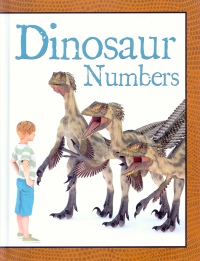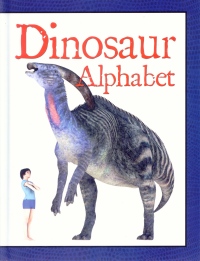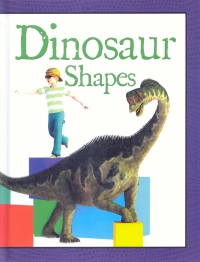| ________________
CM . . .
. Volume XX Number 9. . . .November 1, 2013
excerpt:
Teaching their young children how to count from one to 10 is something that most parents do, and Dinosaur Numbers will be a useful tool for them to use in that task. However, West adds a twist by beginning with “0 Zero”, a double-page spread that introduces youngsters to Tom who is asleep in his bed, with West’s text reading, “No dinosaurs here, but what’s happening in Tom’s dream?” The next 10 double-page spreads show Tom interacting with an increasing number of dinosaurs, from “1 One”...“lonely Ankylosaurus” (ang-KILE-uh-SAWR-us) looking for its herd to “10 Ten”...“tiny Mononykuses” (mo-NON-ih-kus) that “keep together to stay safe.” The closing illustration sees a pajama-clad Tom sitting on the side of his bed while wiping the sleep from his eyes. All of the dinosaurs are gone, but models of a Triceratops (try-SAIR-uh-tops) and a Brachiosaurus (BRACK-ee-uh-SAWR-us) are on top of Tom’s bed (and they weren’t there in the opening spread!). West’s closing text invites readers to “help Tom remember all the dinosaurs in his dream”. To assist readers in understanding the sizes of the various dinosaurs, West uses Tom as his yardstick (metrestick?), and so the eight Brachiosauruses truly tower over Tom (who appears to be about eight to 11 years of age) while Tom seems to be about the same height as the four Beipiaosauruses (bay-pyow-SAWR-us), and the seven Velociraptors (veh-loss-ih-RAP-tor) just come up to his chest. The book’s only weakness is that occasionally some of the dinosaurs’ parts get somewhat lost in the book’s gutter, with that being especially true of the head of one of the three Utahraptors (Yoo-tah-RAP-tor). Note that in each of the four books in the “I Learn with Dinosaurs” series, West does provide a pronunciation guide for the dinosaurs’ names, and adults would be advised to practice some of these dinosaur tongue twisters before reading the books to their children. Parents just beginning to teach their children the alphabet might want to start with a book that connects the letters of the alphabet to simple words, such as “Aa is for apple”, rather than Dinosaur Alphabet that begins with “Aa Alioramus ah-lee-o-TAH-mus” and concludes with “Zz Zuniceratops zoo-nee-SAIR-uh-tops”. Pairs of facing pages or double-page spreads each treat from one to three letters of the alphabet. As in Dinosaur Numbers, a child is used as the yardstick to the sizes of the various dinosaurs in Dinosaur Alphabet. Readers who have already encountered Dinosaur Numbers will recognize Tom, but he is now joined by other children, including some girls. The children of various races are usually shown interacting with the dinosaurs in some way. For example, a bicycle-riding Tom is seen racing a Utahraptor and a Velociraptor in one double-page spread. Unlike Dinosaur Numbers, Dinosaur Alphabet does not have any text beyond the name of the dinosaur and how that name is to be pronounced. Youngsters who have already mastered the alphabet will delight in tackling the names of these 26 dinosaurs. In the same way that Dinosaur Numbers was not a beginner alphabet book, Dinosaur Colors would not be the initial book that parents would use to introduce their very young children to the names of colours. As can be seen in the “excerpt” above, like Dinosaur Numbers, each of the colours in Dinosaur Colors has a brief text that describes what the dinosaur(s) and/or a child are doing. The opening colours of white (snow) and black (night sky) are followed by gray (fog or an Ankylosaurus - ang-KILE-uh-SAWR-us), with the text explaining that “Gray is made from mixing black and white.” This pattern is repeated with the colours now being represented by cans of house paint. Pages for red and yellow come before orange, which is red and orange mixed together, and blue plus yellow then yield green while red and blue make purple. A rainbow of red, orange, yellow, green. blue and purple are mixed together to make brown. The final double-page spread finds Tom being watched by a pair of thirsty Juravenators (JOO-ruh-ven-AT-tor) while he adds red strawberry syrup to his white milk to produce a pink beverage. The book’s closing page has a Venn-like diagram that shows how colours can be mixed together to produce new colours. Younger children can simply name the colours they see throughout Dinosaur Numbers while older children, with access to liquid colours, could be encouraged to replicate the colour mixing described in the text. Dinosaur Shapes introduces youngsters to five two-dimensional shapes (circle, triangle, square, rectangle and oval) plus six shapes that have three dimensions (sphere, pyramid, cube, prism, cone and cylinder). A closing page repeats the shapes and asks, “Can you remember the names of all these shapes?” To assist readers, the two types of shapes are separated and are also coloured differently. Each double-page spread is given over to a single shape, and varying numbers of that shape are found in the objects with which the children and/or dinosaurs are interacting. In each spread, the reader is asked to find a certain number of the target shape. For example, with the circle pages, readers are challenged with, “How many circles can you see on his bike?” The cone pages again find Billy riding his bike, this time through some traffic cones. The task for the reader is to identify the number of cones in the picture. (Trick question: One cone that may be overlooked is the ice-cream cone being eaten by the girl watching Billy.) Note that this book does not have an answer key. Younger readers should be able to deal with the two dimensional shapes, but they may have difficulty with the three dimensional shapes that are being rendered in a two-dimensional medium, especially if these children have not yet learned the conventions, such as shading, that are used in representing three dimensions. Dinosaur books are always in demand, and West has come up with a new way of presenting these ancient creatures by utilizing them in concept books. While all four books in the “I Learn with Dinosaurs” series are worthy of purchase, parents need to recognize that the quartet’s contents need to be used to reinforce already learned concepts rather than to initially teach them. Highly Recommended. Dinosaur Numbers. Highly Recommended. Dinosaur Alphabet. Recommended. Dinosaur Colors. Recommended. Dinosaur Shapes. Dave Jenkinson, CM’s editor, lives in Winnipeg, MB.
To comment
on this title or this review, send mail to cm@umanitoba.ca.
Copyright © the Manitoba Library Association. Reproduction for personal
use is permitted only if this copyright notice is maintained. Any
other reproduction is prohibited without permission.
NEXT REVIEW |
TABLE OF CONTENTS FOR THIS ISSUE
- November 1, 2013.
AUTHORS |
TITLES |
MEDIA REVIEWS |
PROFILES |
BACK ISSUES |
SEARCH |
CMARCHIVE |
HOME |



